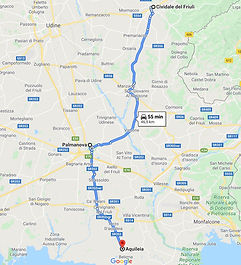Ontdek Friuli met je eigen gids / Discover Friuli with your own guide / Scopri il Friuli con la tua guida privata /
Entdecken Sie Friaul mit Ihrer eigenen Fremdenführerin
The Unesco Day Trip
Book a Unesco day trip and visit with your own guide:
Cividale, Palmanova and Aquileia
Three fascinating and interesting Unesco cities in the province of Udine

Cividale del Friuli,the Duchy of the Longobards
The first city we visit on the World Heritage List in the province of Udine is the medieval town Cividale del Friuli, situated very close to the Slovenian border. Cividale was originally founded by Julius Caesar but 6 centuries later it became the first Duchy of the Longobards in Italy, who ruled over a big part of Italy for about 250 years. The town itself has been a UNESCO World Heritage site since 2011 because of the precious presence of artefacts out of the Longobard period dating mid eight century. The most famous one is the very well preserved little church called "Tempietto Longobardo".
The sense of history is tangible as you walk through Cividale del Friuli's medieval streets and any visit can not end without having crossed the famous devil bridge "Ponte del Diavolo" over the Natisone river. Cividale is truly one of the region's must-see highlights. For more information about Cividale, click on the button.

Palmanova, the Venetian fortress
The second city in the province of Udine on the World Heritage List of Unesco we visit, is Palmanova.
Palmanova is a very well preserved nine- pointed star shape fortress-city built by the Republic of Venice in 1593. National monument since 1960, Unesco site since 2017 because of the still existing Venetian Works of Defence Systems, built in between the 16th and 17th century.
With its perfect nine-pointed star shape, the three monumental entrance gates and the three circles of fortifications walls, of which the most recent one was built by Napoleone Bonaparte in the 19th century, Palmanova is not only a fortress city but also a model of the ideal Renaissance city. The visitors can observe the science of fortification building dating from the Renaissance- to the modern era. The Piazza Grande, a large parade ground located in the exact centre of the fortress city, hosts the church and the most important buildings. For more information about Palmanova click on the button.

Aquileia, the roman city
The third Unesco World Heritage city we visit in the province of Udine is Aquileia. Once called "the second Rome" because of its importance as a military river port city during the Roman Empire thanks to its strategical position. In the fourth century it became the main centre for the diffusion of Christianity in Northern and Eastern Europe. It represents an extraordinary opportunity to broaden your knowledge about this specific time period, offering an unforgettable visiting experience.
In 1998 it was declared as the first Unesco site in Friuli, due to the importance of not only the interesting archaeological excavation areas but especially because of the very well preserved early 4th century mosaic floor inside the main attraction; the Basilica di Santa Maria Assunta. Here you can admire the biggest early christian mosaics floor in Europe of 750 m2!
A visit to the Basilica complex, the excavations areas of the old river port and the Roman forum will be included in your visit. For more information about Aquileia click on the button.


















